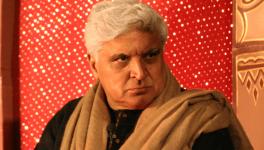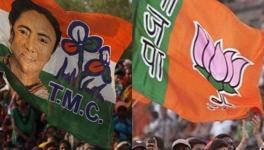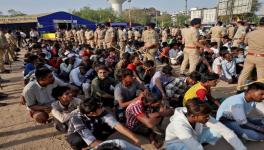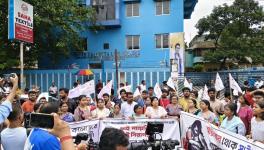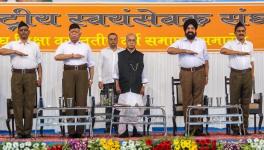West Bengal: Good Response to General Strike Sign of Left’s Resurgence
Kolkata: The good response to the November 26 countrywide general strike and Grameen bandh in West Bengal’s industrial belts and rural areas takes the slowly manifesting rejuvenation of Left politics in the state a step forward, coming as it did at a time when political parties are getting busy, individually and jointly, in strategy exercise for the next Assembly elections due next summer.
The response to the strike against the Narendra Modi government’s pro-industrialist, anti-labour, anti-farmer and overall anti-people policies is being assessed by political observers and analysts as a booster for the Left-Congress alliance. The reason: the outcome brings the Left-Congress platform in reckoning for the upcoming poll battle at a time when the Bharatiya Janata Party, the new aggressive contender for power in the state, “does not want to waste time targeting the alliance”. And the ruling Trinamool Congress, so long considering the tie-up as of little consequence, suddenly changing its stance to “we wish the alliance gathers strength; for that will stand TMC in good stead”.
The task of the strike organisers was made somewhat difficult by the TMC government’s express policy of opposing strikes in pursuance of which it announced that “normal life won’t be allowed to be disturbed”. However, Left party activists and supporters still hit the streets in huge numbers to register their protest against the anti-people policies of the Modi government.
The support the strike evoked was spontaneous. Taking note of the strike day situation, political analysts have veered round to the view that although some new factors have emerged of late, and some differences in the Left camp still remain to be reconciled, the Left-Congress platform may well be in the reckoning.
Thus, Prof Subhamoy Maitra of Indian Statistical Institute inferred that if the rejuvenation of Left politics in the state gathers pace in the coming months, the state would witness a triangular contest. In which situation both TMC and BJP may think the outcome will be favourable for them. But, in elections there are many undercurrents, which cause surprises. Prof Maitra questioned, “Was BJP’s success in 18 Lok Sabha seats, out of 42, in the 2019 elections not a surprise?”
Responding to a question about the BJP leadership’s publicly stated position that the party does not want to attach any importance to the joint platform in its campaigns, he said, “It does not make sense to underestimate a rival.” Suffice it to say at this stage that if the alliance partners are able to significantly step up their political activity in the run-up to battle of the hustings, the situation will sure warrant a reassessment, the academic told NewsClick.
Also read: West Bengal: 21 Organisations under AIKCC to Join Nationwide Strike on November 26
In the opinion of Prof Debasis Sarkar, principal of Chandernagore College, the noticeable participation in the general strike and grameen bandh has given some clear political indications. Alongside farmers and workers, the participants included large sections of youths. The bread and butter issues arising from the Centre’s crony capitalism did appeal to the kisans and workers. The loss of millions of jobs during the pandemic and the Centre’s silence on creation of job opportunities are causing concern to the youths, who are seeing an uncertain future for them. That’s why they came forward to take part in the protest, he said.
“Over the past several years, it has been the usual sight of elderly, senior politicians taking part in agitations held under the banner of the Left parties. The position started changing in the aftermath of the supercyclone Amphan and COVID-19. Youths not only stepped up their social networking but also played active roles in the relief programmes launched by the parent political parties. And, now this participation. This kind of massive coordinated action was witnessed during the 1978 devastating floods. All these point to creation of space, after many years, for a meaningful youth role in reviving people’s interest in Left politics,” Prof Sarkar told NewsClick, adding that the Congress is also gearing itself up.
The state Congress, with MP Adhir Chowdhury at the helm, has become active in the recent past, organising meetings under its banner and actively taking part in rallies and programmes scheduled jointly by the party and the Left Front. The understanding so far has been smooth and sources in both sides are hopeful that differences during the seat distribution exercise won’t be irreconcilable. Both sides have learnt from their unhappy experience on tie-up issues for the 2019 Lok Sabha elections, the sources added.
In the Left camp, the debate that raged for about two weeks over who – BJP or TMC and BJP both -- should be their prime target in campaigns seem to have subsided for now. As the debate followed certain observations of the Communist Party of India (Marxist Leninist) Liberation general secretary Dipankar Bhattacharya, which seemed to suggest that he was for greater emphasis on targeting BJP, NewsClick spoke with him about their party’s, particularly in view of the Communist Party of India (Marxist)’s stand that both TMC and BJP should be the prime targets.
Bhattacharya, who was in Kolkata recently for party work, said, “There is no question of going soft on TMC; my observations have, perhaps, not been understood. What I meant is that instead of competing with BJP in opposing TMC, it should be the other way round – the Left-Congress alliance should compete with TMC in opposing BJP.” On this issue, in an interview to the Bengali daily Ei Samay, he said it should not be an instance of an anti-TMC essay and an anti-BJP footnote.
“Talks on fighting the elections along with CPI-M or the Left Front are yet to start; it will first begin at the state level and then be followed up at the national level. CPI (ML) will field a small number of candidates and nominees may include Adivasis,” he further added.
Owaisi’s AIMIM May Split Votes
In West Bengal, the 27-28% Muslim vote is an important factor and since 2011, Mamata Banerjee’s TMC has been able to corner the maximum share of this vote. However, this time the situation may prove tricky with Assauddin Owaisi of All India Majlis-e-Ittehadul Muslimeen (AIMIM) firm on fielding a number of candidates in the districts bordering or in the vicinity of Bihar’s Seemanchal, where AIMIM won five seats in the recent Bihar Assembly elections. AIMIM’s national spokesman Asim Waqar told NewsClick his party will organise a local unit before long and set the ball rolling.
Then, there are signs of a rift in the well-known Muslim pilgrimage Furfura Sharif where the key figure Peerjada Twaha Siddqui is known to be pro-TMC. Now, Twaha’s nephew Peerjada Abbas Siddiqui, whom Adhir Chowdhury met recently, is understood to be planning to fight the elections either by floating an outfit or in alliance with other parties.
What it boils down is that there is every possibility of the Muslim votes getting split. It is also clear that the Left Front-Congress combine, too, will try hard to enlist support of the Muslims. Banerjee’s task of securing Muslim support, therefore, may be a little difficult.
Adding to this difficulty is the manifesting dissent in the party. Her transport minister and an influential Purba Medinipur leader Suvendu Adhikari has been singing a different tune over the last several weeks, and party leader and Lok Sabha member Saugata Roy has met Suvendu three-four times in a bid to sort out his “grievances”. One among his grievances certainly is the dominant role in the party of Mamata’s nephew and Lok Sabha member Abhishek Banerjee. Success has so far eluded Roy. Even as the Suvendu mystery persists, disgruntled South Cooch Behar TMC MLA Mihir Goswami has decided to leave the party.
Mamata Banerjee Announcing Sops
Meanwhile, Chief Minister Mamata is on an announcement-spree. Apparently taking note of the massive response that Rashtriya Janata Dal leader Tejashwi Yadav’s 10 lakh job-creation promise evoked during the Bihar elections and which later forced BJP-Janata Dal (United) to promise 19 lakh jobs, she announced her intention to create 35 lakh jobs in three years. Her latest move is to extend the state’s health scheme Swasthya Sathi, to the entire population. Many welfare schemes for backward classes also have been announced.
On the other, BJP, which is challenging Mamata with its “Hame Bangal chahiye (we want Bengal)” slogan, is sending its top leaders from New Delhi at short intervals and has divided the state into five zones, each under a pravari, for intensive organisational work. The saffron party, too, has its share of dissident activity and its chief Jagat Prasad Nadda has issued several warnings to the dissidents to cease and desist.
What is clear at this stage is that the headquarter leadership will exercise full control over the West Bengal Assembly elections. Interestingly, in the recent past, Prime Minister Narendra Modi has almost made it a habit to pay respects to Bengal’s iconic figures.
Also read: West Bengal: Left Makes Grassroots Push Amid TMC-BJP Slugfest
Get the latest reports & analysis with people's perspective on Protests, movements & deep analytical videos, discussions of the current affairs in your Telegram app. Subscribe to NewsClick's Telegram channel & get Real-Time updates on stories, as they get published on our website.












